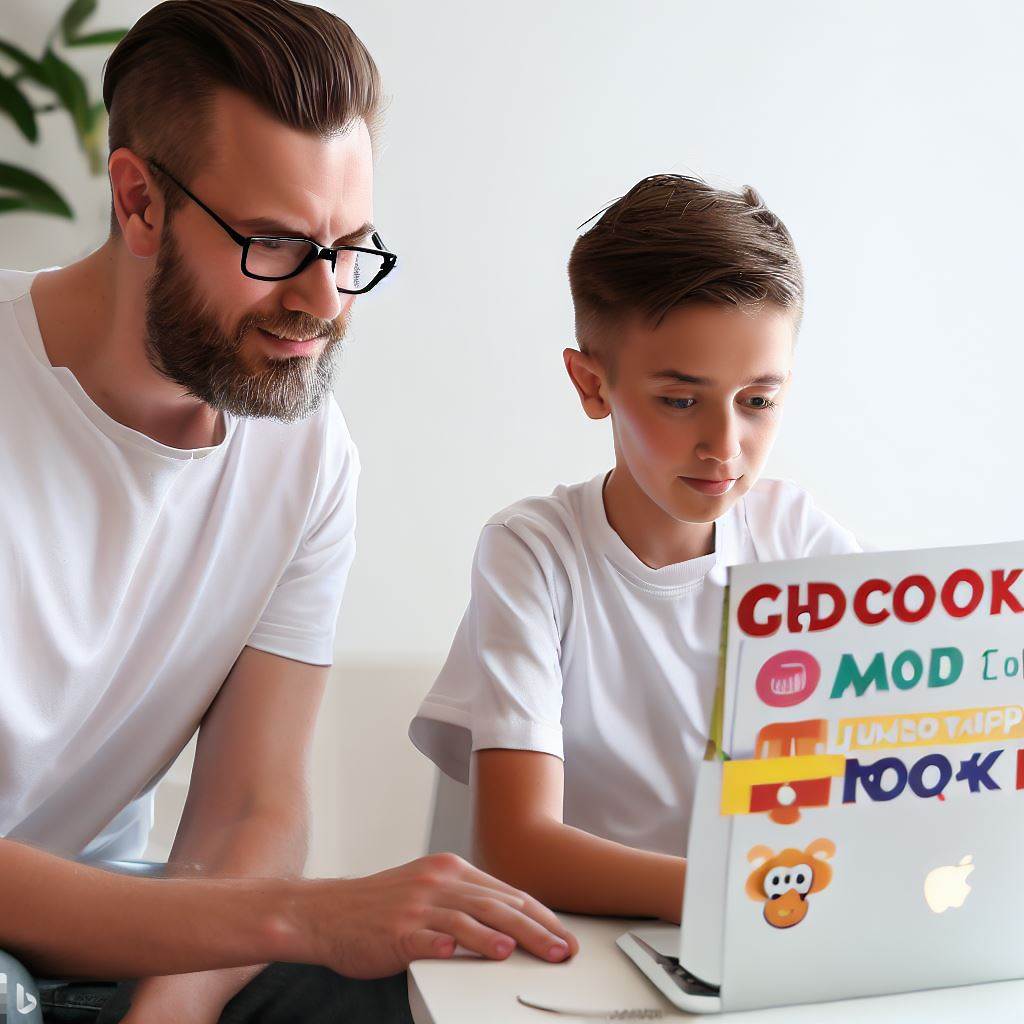Introduction
Tracking progress in CodeMonkey is an essential aspect of a child’s coding education. parents’ involvement plays a crucial role.
Briefly, introduce the topic of tracking progress in CodeMonkey
Tracking progress in CodeMonkey allows parents to monitor their child’s coding journey and assess their development.
Explain the importance of parents being involved in their child’s coding education
Parents being involved in their child’s coding education fosters a supportive learning environment, enhances motivation, and provides guidance and encouragement.
Being actively engaged in their child’s progress strengthens the parent-child bond and helps them understand their child’s strengths and areas for improvement.
Parents can effectively address any learning challenges their child may face and ensure they receive the necessary support.
By tracking progress, parents can celebrate achievements alongside their child, boosting confidence and self-esteem.
Additionally, having a clear understanding of their child’s progress enables parents to set realistic goals and expectations.
Parents can use the tracking information to have meaningful discussions with their child’s teacher, allowing for effective collaboration between home and school.
Ultimately, parental involvement empowers children to succeed and nurtures a lifelong love for coding and technology.
Significance of tracking progress in CodeMonkey
Tracking progress in CodeMonkey is not just important, it is crucial for both parents and students.
By monitoring progress, parents can actively participate in their child’s coding journey, while students can see their growth and celebrate their achievements.
Let’s delve into the significance of tracking progress in CodeMonkey and highlight its benefits.
- Measure Learning: Tracking progress allows parents to gauge their child’s learning and development in coding.
It provides insights into the skills they have mastered and the ones they need to work on. - Parental Involvement: By monitoring progress, parents can actively engage in their child’s coding education.
They can keep track of the coding concepts their child is learning and help them navigate through challenges. - Motivation and Engagement: Tracking progress serves as a motivator for students.
When they see their progress charted out, it provides a sense of accomplishment and keeps them engaged in the learning process. - Identifying Challenges: Progress tracking helps identify areas where a student may be facing difficulties.
This allows parents and teachers to provide the necessary assistance and support to overcome those challenges. - Goal Setting: By having a clear understanding of their progress, students can set achievable goals for themselves.
They can aim for specific coding milestones and work towards achieving them, fostering a sense of purpose and direction.
Benefits of Monitoring Progress for Parents
- Insight into Learning: Tracking progress gives parents a comprehensive view of their child’s coding progress.
They can see the concepts their child has mastered and identify areas where they may require additional guidance. - Encouragement and Support: Progress tracking allows parents to provide encouragement and support to their child.
They can celebrate achievements together and assist in overcoming any challenges their child may face. - Effective Communication with Teachers: By understanding their child’s progress, parents can effectively communicate with their teachers.
They can discuss specific areas of improvement and collaborate on strategies to enhance their child’s learning experience. - Identifying Passion and Aptitude: Monitoring progress can help parents identify their child’s particular interests and strengths in coding.
This knowledge can guide them in providing additional resources or opportunities aligned with their child’s passion.
Benefits of Monitoring Progress for Students
- Self-Awareness: Tracking progress allows students to develop self-awareness in coding.
They can identify their strengths and weaknesses, enabling them to focus on areas that require improvement. - Personal Goals: Progress tracking enables students to set personal goals for their coding journey.
They can strive for incremental achievements and experience a sense of fulfillment upon reaching their targets. - Celebrating Achievements: By monitoring progress, students can visualize their growth and celebrate their coding accomplishments.
This fosters a sense of pride and boosts their confidence in their coding abilities. - Continuous Improvement: Progress tracking helps students identify areas for improvement.
They can work on enhancing specific coding skills and monitor their growth as they progress through different coding challenges.
Therefore, tracking progress in CodeMonkey is vital for parents and students alike.
It provides valuable insights, fosters motivation, and enables effective support.
With progress tracking, parents can actively engage in their child’s coding education, while students can visualize their growth and celebrate their achievements.
Start tracking progress in CodeMonkey today, and embark on an exciting coding journey!
Read: CodeMonkey and Girls: Closing the Gender Gap in Coding
Tech Consulting Tailored to Your Coding Journey
Get expert guidance in coding with a personalized consultation. Receive unique, actionable insights delivered in 1-3 business days.
Get StartedOverview of tracking tools in CodeMonkey
In CodeMonkey, there are several tracking tools available to monitor a child’s progress.
- The dashboard provides an overview of a child’s progress, displaying completed challenges and earned stars.
- Progress reports highlight a child’s overall progress and identify areas that may need improvement.
- The achievements section showcases the badges a child has earned, giving parents a sense of their accomplishments.
Code completion charts provide a visual representation of a child’s coding progress over time.
Parents can also view specific progress details for each completed challenge, including time spent and stars earned.
The leaderboard feature allows parents to compare their child’s progress to other CodeMonkey users.
The students’ gallery displays their game solutions, enabling parents to see their problem-solving skills in action.
CodeMonkey also offers detailed analytics, including how long it takes a child to complete each challenge.
Parents can track their child’s activity in the “My Children” section, which shows a detailed breakdown of completed challenges.
By utilizing these tracking tools, parents can gain insights into their child’s coding journey.
They can identify areas of strength, focus on weaknesses, and celebrate milestones.
With CodeMonkey’s tracking features, parents can actively support their child’s learning and growth.
Read: Is CodeMonkey Accessible for Special Needs Students?
Setting up a parent account
Setting up a parent account in CodeMonkey is quick and easy.
Here’s a step-by-step guide to help you get started:
- Visit the CodeMonkey website and click on the “Sign Up” button located at the top right corner of the homepage.
- Fill out the required information in the sign-up form, including your email address and a secure password.
Click on “Create Account” to proceed. - Once your account is created, you will receive a verification email.
Open the email and click on the verification link to activate your account. - After verifying your account, log in using your email and password.
- Upon logging in, you will see the CodeMonkey dashboard.
On the left-hand side, click on the “Settings” tab. - In the settings menu, select “Family Account” to set up your parent account.
- Fill in your details as a parent, including your name and relationship to the child.
Click on “Create Account” to proceed. - Now you have successfully set up your parent account.
You can also link your child’s account to your own to track their progress.
Explain the process of linking their child’s account to their own.
- To link your child’s account, go back to the CodeMonkey dashboard and click on the “Students” tab on the left-hand side.
- Click on “Add New Student” and fill in your child’s details, including their name and grade level.
Click on “Save” to proceed. - Once your child’s account is created, click on the “Link to Parent” button next to their name.
- You will be prompted to enter your child’s username and password for verification.
Enter the details and click on “Link Account” to connect their account to yours. - Congratulations! You have successfully linked your child’s account to your parent account in CodeMonkey.
- Now you can easily track your child’s progress by accessing their account from your parent dashboard.
- The parent dashboard provides an overview of your child’s achievements, completed levels, and coding projects.
- You can also view detailed progress reports, including the time spent on each level and the number of challenges completed.
- Additionally, you can monitor your child’s coding skills through the game-based assessments and quizzes available in CodeMonkey.
- With CodeMonkey’s progress tracking feature, parents can stay informed and engaged in their child’s coding journey.
- Encourage your child to explore different coding challenges and projects while you monitor their growth and development.
- By actively participating in your child’s coding education, you can support their learning and help them succeed in the digital age.
Read: History of Competitive Programming: The Great Coding Wars
Build Your Vision, Perfectly Tailored
Get a custom-built website or application that matches your vision and needs. Stand out from the crowd with a solution designed just for you—professional, scalable, and seamless.
Get StartedNavigating the CodeMonkey dashboard
- Upon logging in, parents are greeted with the CodeMonkey dashboard, which serves as a central hub.
- The dashboard interface is user-friendly, with clearly labeled sections and tabs for easy navigation.
- Parents can access their child’s progress reports and other relevant information in just a few simple steps.
Understanding the different sections and tabs
- One of the main sections in the CodeMonkey dashboard is the “Progress” section.
- This section gives parents an overview of their child’s coding journey, highlighting completed lessons and future challenges.
- Within the “Progress” section, parents will find a “Level Map” tab that displays a visually appealing map.
- By hovering over the different levels on the map, parents can see the difficulty and objectives of each level.
- Another significant section in the dashboard is the “Reports” section, accessible through the top navigation menu.
- Clicking on the “Reports” tab will open a drop-down menu with several options, including “Progress Reports”.
- Under the “Progress Reports” tab, parents can view detailed reports on their child’s progress and accomplishments.
- The reports provide insights into completed levels, exercises, challenges, and coding concepts mastered.
- In addition to progress reports, parents can also access “Activity Reports” under the “Reports” menu.
- Activity reports offer a comprehensive breakdown of the time spent by the child on CodeMonkey.
Accessing progress reports and relevant information
- To access their child’s progress reports, parents should click on the “Reports” tab in the top navigation menu.
- A drop-down menu will appear, and parents should select “Progress Reports” from the available options.
- Once in the progress reports section, parents can filter the data by date range, level, or skill.
- The reports include detailed information such as completed levels, achievements, and coding concepts learned.
- Parents can also download a PDF version of the progress reports to keep a record of their child’s accomplishments.
- Aside from progress reports, parents can explore other tabs in the “Reports” section for more information.
- The “Time Played” tab provides insights into the amount of time spent by the child on CodeMonkey.
- By examining this data, parents can gauge their child’s engagement and dedication to coding.
- The “Challenges Solved” tab showcases the challenges completed by the child, along with the time taken.
- These challenges allow parents to assess their child’s problem-solving skills and development.
Navigating the CodeMonkey dashboard is an intuitive process, allowing parents to keep track of their child’s progress in coding.
The distinct sections and tabs provide easy access to progress reports and other relevant information, enabling parents to stay informed and involved in their child’s coding journey.
Read: How Coding Academies Prepare You for the Job Market

Understanding Progress Reports in CodeMonkey: A Parent’s Guide
Tracking your child’s progress in CodeMonkey is essential for ensuring their success and growth as a coder.
CodeMonkey provides progress reports that allow you to monitor their development in a structured and comprehensive manner.
Interpreting Progress Reports: Unleashing the Insights
At first glance, the progress reports in CodeMonkey might seem overwhelming, but they hold valuable information about your child’s coding abilities.
By understanding how to interpret these reports, you can gain insight into their strengths and areas for improvement.
Metrics and Indicators: Measuring the Path to Success
The progress reports in CodeMonkey rely on various metrics and indicators to measure your child’s progress.
These metrics include completed levels, the number of stars earned, and the time spent on each level.
- Completed Levels: This metric indicates the number of levels your child has successfully completed, showcasing their proficiency in solving coding challenges.
- Stars Earned: CodeMonkey assigns stars based on how well your child performs in each level.
More stars indicate a higher level of understanding and proficiency. - Time Spent: The progress reports also reveal how much time your child spends on each level.
This metric can indicate their level of engagement and dedication to mastering coding skills.
Tips for Using Progress Reports: Enhancing Your Child’s Learning Journey
- Set Goals: Use the progress reports to set realistic goals for your child.
For example, aim for a specific number of completed levels or an increased number of stars earned. - Celebrate Achievements: Recognize and celebrate your child’s accomplishments as seen in the progress reports.
This positive reinforcement will motivate them to continue their coding journey. - Identify Weak Areas: Analyzing progress reports helps you identify areas where your child may be struggling.
Focus on these areas to provide targeted support and practice. - Track Improvements: As your child progresses, compare their earlier progress reports with the latest ones.
Observe improvements and take pride in their growth as a coder. - Encourage Creativity: While progress reports mainly focus on completed levels, challenge your child to go beyond and create their own projects or solve additional coding problems.
- Communicate with Teachers: Share the progress reports with your child’s coding teacher or mentor.
This collaboration between home and school can lead to a more comprehensive learning experience.
By utilizing the progress reports in CodeMonkey, you can actively stay involved in your child’s coding journey and help them thrive as a successful coder.
Communication with Teachers through CodeMonkey
Staying connected with your child’s coding teacher is essential for tracking progress in CodeMonkey.
CodeMonkey recognizes the importance of this connection and provides tools and features to facilitate communication between parents and teachers.
Importance of Staying Connected with the Child’s Coding Teacher
Keeping in touch with your child’s coding teacher allows you to have a clear understanding of their progress, challenges, and areas of improvement.
By staying connected, you can actively support your child’s coding journey and ensure they receive the necessary guidance.
Optimize Your Profile, Get Noticed
Make your resume and LinkedIn stand out to employers with a profile that highlights your technical skills and project experience. Elevate your career with a polished and professional presence.
Get NoticedHow CodeMonkey Facilitates Communication between Parents and Teachers
CodeMonkey offers a user-friendly platform that promotes effective communication between parents and teachers.
The following features enable seamless interaction:
- Teacher Messaging System: CodeMonkey’s messaging system allows parents to directly communicate with their child’s coding teacher.
This platform ensures quick and convenient communication. - Progress Reports: CodeMonkey provides detailed progress reports to parents, showcasing their child’s achievements, areas of improvement, and specific coding skills they have developed.
- Live Online Classes: CodeMonkey offers live online classes where parents can participate and observe their child’s learning process.
These classes provide an opportunity to interact with the teacher and gain insights into the coding curriculum.
Guidance on Utilizing the Communication Channel Effectively
To make the most out of the communication channel between parents and teachers, follow these effective practices:
- Regularly Check Messages: Stay updated by regularly checking messages from your child’s coding teacher.
This ensures you stay informed about any announcements, feedback, or queries. - Ask Questions: Don’t hesitate to ask questions or seek clarification from the teacher.
Direct communication helps address any concerns and enhances your understanding of your child’s progress. - Share Concerns or Observations: If you notice any issues or have specific observations about your child’s learning experience, share them with the coding teacher.
This collaborative approach ensures a more personalized learning journey for your child. - Utilize Progress Reports: Review the progress reports provided by CodeMonkey.
These reports offer insights into your child’s coding skills and can guide you in supporting their learning process. - Attend Live Online Classes: Take advantage of the opportunity to attend live online classes.
Engage with the teacher and ask questions to deepen your understanding of the coding concepts being taught.
By actively utilizing the communication channel provided by CodeMonkey, you can play an active role in your child’s coding education.
Stay engaged, ask questions, and support your child’s progress to ensure a successful coding journey!
Additional Tips and Strategies for Tracking Progress in CodeMonkey
- Regularly review your child’s progress reports to gain insights into their coding skills and areas for improvement.
- Encourage your child to set specific goals for their coding journey and track their progress against these goals.
- Utilize CodeMonkey’s “Playground” feature to monitor your child’s coding projects and assess their level of creativity and problem-solving skills.
- Take advantage of CodeMonkey’s parent dashboard, which provides a comprehensive overview of your child’s coding progress.
- Engage in regular conversations with your child about their experiences with CodeMonkey, asking questions to understand their challenges and achievements.
- Provide constructive feedback to your child based on their coding projects and help them brainstorm ideas for improvement.
- Encourage your child to participate in coding competitions or challenges within the CodeMonkey community to inspire them and boost their motivation.
- Consider setting up a rewards system for your child based on their coding achievements, such as completing a certain number of levels or mastering a specific coding concept.
- Connect with other CodeMonkey parents through forums or online communities to exchange tips and strategies for tracking progress.
- Collaborate with your child’s teacher, if applicable, to align their coding progress in CodeMonkey with their school curriculum and objectives.
Creating a Supportive Learning Environment at Home
- Allocate a dedicated space in your home for your child to engage in coding activities, ensuring it is quiet, organized, and free from distractions.
- Set consistent daily or weekly schedules for coding practice, in accordance with your child’s preferences and availability.
- Provide the necessary tools and resources, such as a computer or tablet, reliable internet connection, and any required software or peripherals.
- Show interest in your child’s coding projects and acknowledge their efforts, creating a positive and encouraging atmosphere.
- Encourage open communication between you and your child, allowing them to freely ask questions or seek help when encountering coding challenges.
- Support your child’s exploration of additional coding resources beyond CodeMonkey, such as online tutorials or coding books.
- Consider enrolling your child in coding classes or clubs to further enhance their learning and provide opportunities for social interaction with peers.
- Stay informed about the latest developments in the field of coding and share relevant news or success stories with your child to keep them motivated and inspired.
- Lead by example by engaging in your own learning pursuits, demonstrating the value of continuous education and personal growth.
Recommendations on Encouraging Regular Practice and Engagement with the Platform
- Set clear expectations with your child regarding the frequency and duration of their coding practice sessions.
- Establish a routine that incorporates coding practice into your child’s daily or weekly schedule.
- Actively participate in your child’s coding sessions, showing enthusiasm and interest in their progress.
- Gamify the coding experience by turning practice sessions into challenges or competitions with rewards.
- Encourage your child to share their coding projects with family members or friends, fostering a sense of achievement and pride.
- Allow your child to explore different coding projects or game levels within CodeMonkey to maintain their engagement and prevent boredom.
- Provide timely praise and encouragement when your child achieves coding milestones or demonstrates improvement.
- Help your child establish connections with other CodeMonkey users, such as joining coding clubs or participating in online forums.
- Regularly review and discuss your child’s coding journey and progress, celebrating their successes and discussing areas for growth.
- Consider organizing coding-themed family activities or events, such as coding challenges or game nights, to foster a love for coding in a fun and interactive way.
The Role of Parents in Motivating and Supporting Their Child’s Coding Journey
- Be your child’s cheerleader, continuously providing encouragement and motivation throughout their coding journey.
- Take an active interest in your child’s coding projects, demonstrating genuine curiosity and appreciation for their efforts.
- Participate in coding activities with your child, allowing for bonding experiences and shared learning opportunities.
- Be patient and understanding when your child faces challenges or struggles with coding concepts, offering guidance and support.
- Celebrate your child’s accomplishments, no matter how big or small, to reinforce their confidence and passion for coding.
- Advocate for your child’s coding education by exploring additional resources or seeking coding opportunities within your community.
- Provide a safe and non-judgmental space for your child to express their coding ideas and experiment with new concepts.
- Encourage continuous learning beyond CodeMonkey, exposing your child to other coding languages or platforms to broaden their skills.
- Regularly communicate with your child’s teacher or mentor to stay informed about their progress and to ensure alignment between home and school learning.
- Emphasize the importance of perseverance, problem-solving, and creativity in coding, highlighting the transferable skills that coding cultivates.
Conclusion
Actively tracking your child’s progress in CodeMonkey is crucial for their coding education.
By regularly monitoring their achievements and challenges, parents can provide the necessary support and encouragement.
Parental involvement plays a vital role in fostering their child’s interest and growth in coding.
So, parents, stay engaged and make a difference in your child’s coding journey.
In our blog post, we emphasized the vital role parents play in their child’s CodeMonkey journey. Here are the key takeaways:
- Active Tracking: Parents should actively monitor their child’s progress in CodeMonkey regularly.
- Supportive Engagement: Actively engaging in your child’s coding journey fosters a supportive environment.
- Open Communication: Keep lines of communication open to discuss challenges and achievements.
- Celebrate Success: Celebrate your child’s coding milestones to boost their confidence and motivation.
- Set Goals Together: Collaborate with your child to set achievable coding goals.
- Regular Check-Ins: Schedule regular check-ins to review progress and offer assistance.
- Stay Informed: Familiarize yourself with CodeMonkey’s curriculum to better guide your child.
- Online Resources: Take advantage of CodeMonkey’s parent resources and support materials.
- Encourage Exploration: Encourage your child to explore coding independently.
- Feedback Loop: Provide constructive feedback to help your child improve their coding skills.
Remember, your active involvement and support are essential for your child’s success in CodeMonkey!




